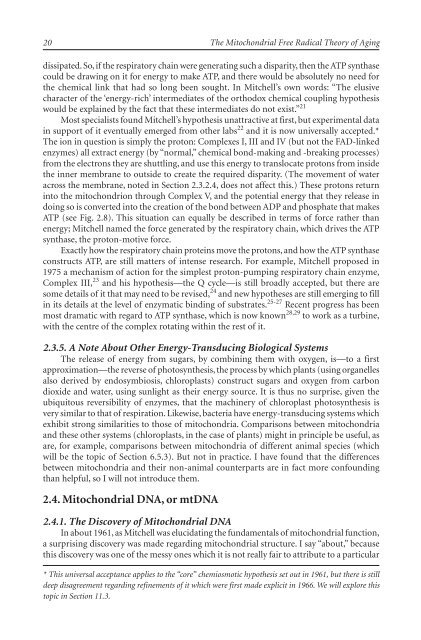The Mitochondrial Free Radical Theory of Aging - Supernova: Pliki
The Mitochondrial Free Radical Theory of Aging - Supernova: Pliki
The Mitochondrial Free Radical Theory of Aging - Supernova: Pliki
You also want an ePaper? Increase the reach of your titles
YUMPU automatically turns print PDFs into web optimized ePapers that Google loves.
20<br />
<strong>The</strong> <strong>Mitochondrial</strong> <strong>Free</strong> <strong>Radical</strong> <strong>The</strong>ory <strong>of</strong> <strong>Aging</strong><br />
dissipated. So, if the respiratory chain were generating such a disparity, then the ATP synthase<br />
could be drawing on it for energy to make ATP, and there would be absolutely no need for<br />
the chemical link that had so long been sought. In Mitchell’s own words: “<strong>The</strong> elusive<br />
character <strong>of</strong> the ‘energy-rich’ intermediates <strong>of</strong> the orthodox chemical coupling hypothesis<br />
would be explained by the fact that these intermediates do not exist.” 21<br />
Most specialists found Mitchell’s hypothesis unattractive at first, but experimental data<br />
in support <strong>of</strong> it eventually emerged from other labs 22 and it is now universally accepted.*<br />
<strong>The</strong> ion in question is simply the proton: Complexes I, III and IV (but not the FAD-linked<br />
enzymes) all extract energy (by “normal,” chemical bond-making and -breaking processes)<br />
from the electrons they are shuttling, and use this energy to translocate protons from inside<br />
the inner membrane to outside to create the required disparity. (<strong>The</strong> movement <strong>of</strong> water<br />
across the membrane, noted in Section 2.3.2.4, does not affect this.) <strong>The</strong>se protons return<br />
into the mitochondrion through Complex V, and the potential energy that they release in<br />
doing so is converted into the creation <strong>of</strong> the bond between ADP and phosphate that makes<br />
ATP (see Fig. 2.8). This situation can equally be described in terms <strong>of</strong> force rather than<br />
energy; Mitchell named the force generated by the respiratory chain, which drives the ATP<br />
synthase, the proton-motive force.<br />
Exactly how the respiratory chain proteins move the protons, and how the ATP synthase<br />
constructs ATP, are still matters <strong>of</strong> intense research. For example, Mitchell proposed in<br />
1975 a mechanism <strong>of</strong> action for the simplest proton-pumping respiratory chain enzyme,<br />
Complex III, 23 and his hypothesis—the Q cycle—is still broadly accepted, but there are<br />
some details <strong>of</strong> it that may need to be revised, 24 and new hypotheses are still emerging to fill<br />
in its details at the level <strong>of</strong> enzymatic binding <strong>of</strong> substrates. 25-27 Recent progress has been<br />
most dramatic with regard to ATP synthase, which is now known 28,29 to work as a turbine,<br />
with the centre <strong>of</strong> the complex rotating within the rest <strong>of</strong> it.<br />
2.3.5. A Note About Other Energy-Transducing Biological Systems<br />
<strong>The</strong> release <strong>of</strong> energy from sugars, by combining them with oxygen, is—to a first<br />
approximation—the reverse <strong>of</strong> photosynthesis, the process by which plants (using organelles<br />
also derived by endosymbiosis, chloroplasts) construct sugars and oxygen from carbon<br />
dioxide and water, using sunlight as their energy source. It is thus no surprise, given the<br />
ubiquitous reversibility <strong>of</strong> enzymes, that the machinery <strong>of</strong> chloroplast photosynthesis is<br />
very similar to that <strong>of</strong> respiration. Likewise, bacteria have energy-transducing systems which<br />
exhibit strong similarities to those <strong>of</strong> mitochondria. Comparisons between mitochondria<br />
and these other systems (chloroplasts, in the case <strong>of</strong> plants) might in principle be useful, as<br />
are, for example, comparisons between mitochondria <strong>of</strong> different animal species (which<br />
will be the topic <strong>of</strong> Section 6.5.3). But not in practice. I have found that the differences<br />
between mitochondria and their non-animal counterparts are in fact more confounding<br />
than helpful, so I will not introduce them.<br />
2.4. <strong>Mitochondrial</strong> DNA, or mtDNA<br />
2.4.1. <strong>The</strong> Discovery <strong>of</strong> <strong>Mitochondrial</strong> DNA<br />
In about 1961, as Mitchell was elucidating the fundamentals <strong>of</strong> mitochondrial function,<br />
a surprising discovery was made regarding mitochondrial structure. I say “about,” because<br />
this discovery was one <strong>of</strong> the messy ones which it is not really fair to attribute to a particular<br />
* This universal acceptance applies to the “core” chemiosmotic hypothesis set out in 1961, but there is still<br />
deep disagreement regarding refinements <strong>of</strong> it which were first made explicit in 1966. We will explore this<br />
topic in Section 11.3.


